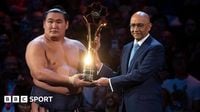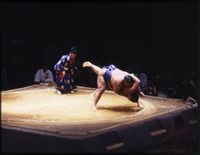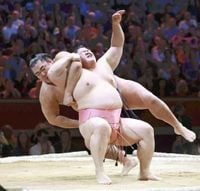Sumo thundered back into London this week, captivating thousands at the Royal Albert Hall as the Grand Sumo Tournament unfolded outside Japan for only the second time in history. From October 15 to 19, 2025, more than 40 elite rikishi—sumo wrestlers—battled in a spectacle brimming with tradition, drama, and a few surprises that had even seasoned fans on the edge of their seats.
The anticipation had been building for months, and it reached fever pitch on opening night. Organizers marked the start with a special ceremony, purifying the grounds to ensure the dohyo—the sacred sumo ring—was spiritually prepared for the contest. The Royal Albert Hall itself underwent a transformation, bringing in chairs capable of supporting 200kg and installing reinforced toilets to accommodate the mighty athletes. Eleven tons of clay and earth were hauled in to create the elevated fighting platform, its boundaries defined by bales of rice pounded into shape with beer bottles. It was a scene both ancient and electric, as tradition met modern spectacle in the heart of London.
Sumo elder Hakkaku, chairman of the Japan Sumo Association and a former Yokozuna who won the 1991 event at the same venue, oversaw the proceedings. He’s been pushing to modernize the sport and expand its global reach, aiming to move past past scandals and embrace a new generation of fans. “The event, the first such sumo match in the UK in 34 years, was aimed at promoting ties between the two countries,” Hakkaku Nobuyoshi said, his words echoed by the presence of a sell-out crowd each night.
Among the wrestlers, the spotlight shone brightly on Grand Champions Onosato and Hoshoryu, both of whom entered the tournament with high expectations. Onosato, a 25-year-old Japanese sensation and the country’s first home-grown champion in nearly a decade, carried a squeaky-clean image and a reputation for power and balance. Hoshoryu, at 26 years old, brought his own brand of intensity and technical prowess to the ring.
Each day, the Royal Albert Hall buzzed with excitement as fans—many experiencing live sumo for the first time—watched the rituals, the salt-throwing, the fierce stare-downs, and the explosive bouts that sometimes ended in mere seconds. The wrestlers, in their long silk belts, stomped and slapped, building tension before launching into action. The crowd, initially reverent, soon erupted into wild cheers, especially when underdogs or fan favorites took to the ring.
Day three delivered one of the tournament’s most jaw-dropping moments. Ura, known affectionately as “The Magician” for his extensive repertoire of techniques, faced the much taller Shonannoumi. After a brief pause to fix loose mawashi belts, Ura spun in front of his opponent and executed a rare tsutaezori move, flipping Shonannoumi onto his back and drawing thunderous applause from the 5,400-strong audience. “I’m so happy to get such applause,” Ura said afterward. “I’m also honored to be called Magician.”
Ura wasn’t done dazzling. On Saturday, he defeated Midorifuji with a spectacular lift, eliciting the loudest cheers of the day. His entrances alone brought the crowd to its feet, but his victories cemented his place as one of the most entertaining figures of the tournament.
Elsewhere, the action was just as fierce. Onosato faced a tricky challenge from Aonishiki, a Ukrainian competitor who had impressed with his own technical skill. Seizing a right underarm belt hold, Onosato used his superior frame to force out his opponent and keep his perfect record intact. Hoshoryu, meanwhile, overcame former ozeki Takayasu in a bout that saw both men trading shoves before Hoshoryu powered through for a force-out win. Tobizaru, the No. 15 maegashira known as “The Flying Monkey” for his push/pull “gorilla” strategy, defeated sekiwake Kirishima with a deep left underarm belt hold and a dramatic throw. Social media buzzed with footage of Tobizaru and his fellow wrestlers enjoying London life—posing at landmarks, riding Lime bikes, and even eating hot dogs on Westminster Bridge.
The tournament was about more than just wrestling. The Japan Sumo Association aimed to capitalize on a worldwide surge in interest in sumo, and the event’s unique blend of ceremony and competition seemed to do just that. The wrestlers consumed about 11 stones (roughly 70 kg) of rice each day, and the noodle wholesaler supplying the event ran out of stock due to the sheer volume of orders. The spectacle extended beyond the ring, with fans and athletes mingling across the city, sharing in the joy of this ancient sport’s modern adventure.
After five days of pushing, lifting, and slapping, it all came down to the final bouts. The tournament, which had been wide open with several undefeated contenders, saw the top-ranking Hoshoryu emerge victorious. At just 26, Hoshoryu put everything he had into the competition, thrilling fans and earning their admiration. “I loved it. I’m a huge Hoshoryu fan, I’m so happy that he won!” one fan told the BBC, echoing the sentiments of many in attendance.
The event concluded with the traditional bow-twirling ceremony, a final gesture to cast out evil spirits from the dohyo. As the celebrations wound down and the crowds began to disperse, the sense of history lingered in the air. The Royal Albert Hall, which last hosted sumo in 1991, had once again witnessed the drama, artistry, and raw power of Japan’s national sport.
But the sumo journey doesn’t end here. The top-tier makuuchi-division wrestlers are set to visit Paris for a two-day tournament in June 2026, continuing their mission to introduce sumo to new audiences around the globe. For now, though, London can savor the memory of a week when ancient ritual met modern spectacle, and sumo took its place on the world stage once again.


